Elephant Bush (Portulacaria Afra): Care and Growing Guide (Including Rainbow Elephant Bush)
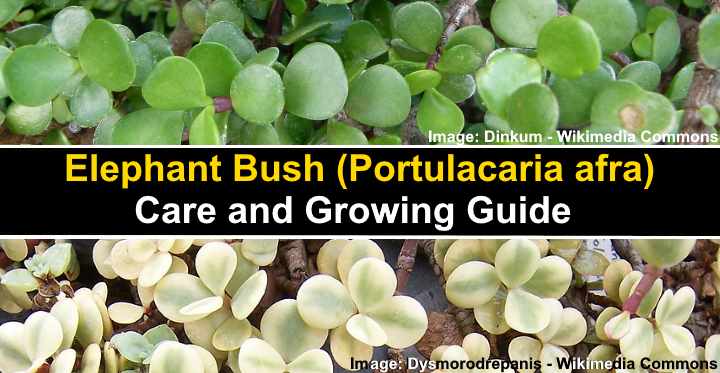
The Elephant Bush plant (Portulacaria afra) is a succulent with small oval fleshy leaves and reddish woody stems. Elephant bush is popular as a hanging basket houseplant succulent due to its colorful trailing stems and jade-colored leaves. There is also a variegated variety—Rainbow elephant bush (Portulacaria afra ‘Variegata’). The rainbow elephant bush succulent has light green and cream-colored round leaves.
This article is a complete care guide to the elephant bush plant and the rainbow elephant bush plant. In addition to helpful care tips, you’ll also find out how to resolve some issues concerning growing varieties of elephant bush plants at home.
What is Elephant Bush (Portulacaria Afra)
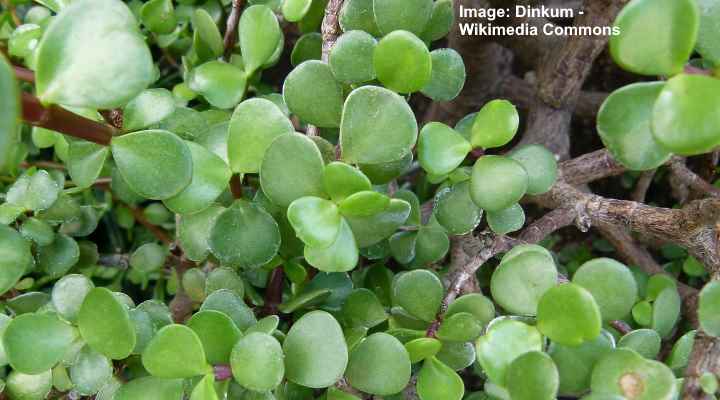
Elephant bush (Portulacaria afra) is a succulent that can grow outdoors in warm climates but is also a popular indoor plant
Elephant bush (Portulacaria afra) is a semi-evergreen shrubby flowering succulent native to South Africa. In the wild, elephant bush grows in dry, sunny locations. Elephant bush is a drought-tolerant plant, ideally suited to growing in arid, desert-like environments.
Elephant bush plants (Portulacaria) thrive in USDA zones 10 and 11. Although large Portulacaria afra bushes can survive some frost, small elephant bush plants are not cold hardy. Temperatures below 30°F (-1°C) damage the plant and can kill it.
Elephant bush is a shrub-like plant or small tree that grows between 8 and 15 ft. (2.5 – 4.5 m) high when grown in the ground and ideal conditions. However, growing as a potted succulent indoors, elephant bush stems only grow a few feet. Their trailing leafy stems make the succulent excellent for placing on high shelves or growing hanging in baskets.

Portulacaria afra bushes grown outdoors
Elephant bush is also a flowering variety of succulent. When growing conditions are right, Portulacaria afra produces masses of star-shaped flowers growing in small clusters. These pink or white flowers grow on the end of stems. But it is rare for elephant bush plants to bloom indoors.

Elephant bush (Portulacaria afra) flowers
Portulacaria afra “Elephant Bush” gets its common name because it’s a favorite food of elephants. Other common names include porkbush and spekboom.
Due to its resemblance to jade plants (Crassula ovata), elephant bush is also called a dwarf jade plant. But elephant bush and jade plants aren’t related to each other. For example, compared to jade succulent plants, elephant bush grows faster and is hardier. Another difference is that elephant bush is an edible succulent, whereas jade leaves (family Crassula) are mildly toxic.
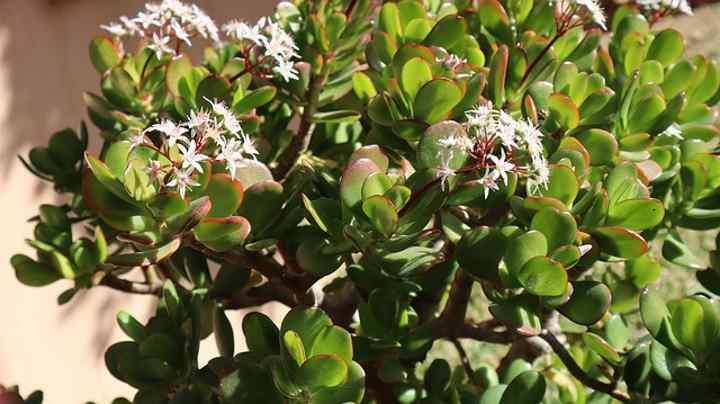
A picture of Crassula ovata (jade plant). The elephant bush (Portulacaria afra) is similar to jade plant, but they are not related
How to Care for Elephant Bush Succulent
To care for Portulacaria afra “Elephant Bush,” grow in sandy, fast-draining soil and put in a sunny spot. Water elephant bush succulents when the soil is dry. The best watering method is to drench the soil and allow excess water to drain. Fertilize monthly in spring and summer with a diluted houseplant fertilizer.
What is Rainbow Elephant Bush (Portulacaria Afra ‘Variegata’)
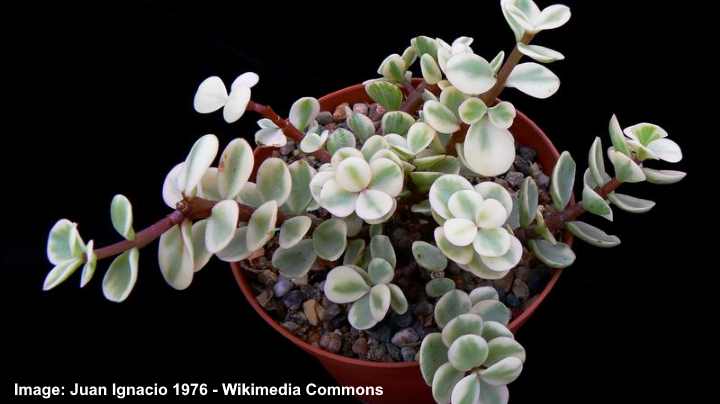
Rainbow elephant bush has variegated cream and green leaves
Portulacaria afra ‘Variegata’ (“Rainbow Elephant Bush”) is a small-leaved succulent with creamy-white and green leaves. This variety of elephant bush has brighter-colored leaves than the darker jade-colored Portulacaria variety. Rainbow elephant bush also has long, reddish, woody stems that grow into a large shrub.
Rainbow Portulacaria plants thrive in arid conditions where there’s plenty of sunshine. In their natural habitat, rainbow elephant bush plants grow up to 20 ft. (6 m) tall. In containers, the variegated plant succulent stems reach about 10 ft. (3 m). Due to their trailing growth, varieties of elephant bush plants are ideal hanging basket plants.
All varieties of Portulacaria, including rainbow elephant bush, flower in ideal conditions. Usually, only outdoor elephant bushes bloom in late spring after warm, dry winters. The small clusters of tiny inconspicuous white or pink-colored flowers are barely noticeable against the light green and cream foliage of rainbow elephant bush.
How to Care for Rainbow Elephant Bush (Variegated Elephant Bush)
To care for Portulacaria afra ‘Variegata,’ grow the rainbow elephant bush in bright indirect light. Plant the variegated elephant bush in a quick-draining sandy soil mix for succulents. Only water the succulent when the soil completely dries. Fertilize in late spring using a diluted houseplant fertilizer.
Elephant Bush (Portulacaria Afra) — Detailed Care Guide
Portulacaria afra “Elephant Bush” succulents are generally easy to care for. But to ensure the heat-loving plants thrive, there is some essential care advice to follow. Typically, elephant bush and rainbow elephant bush require fast-draining soil, plenty of light, and occasional watering.
Let’s look in more detail at how to care for elephant bush.
Light Requirements for Growing Portulacaria Afra “Elephant Bush” Plants
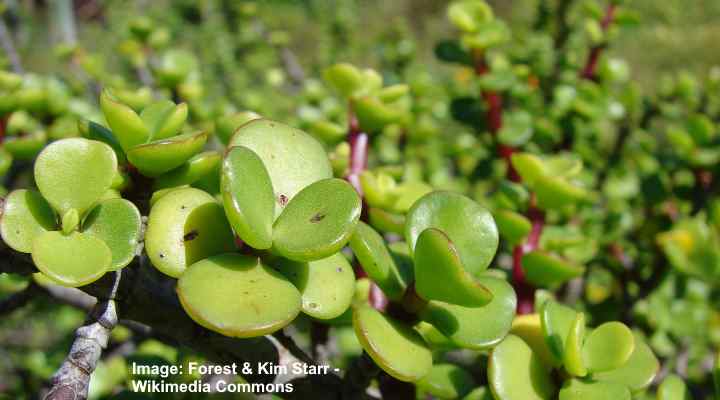
Elephant bush plants need plenty of light to thrive
Elephant bush thrives in bright light. Portulacaria plants can grow in partial shade, but ideally, they need at least six hours of sunlight daily. It’s also essential to protect elephant bush plants from intense direct sunshine. Too much sunlight through a window can cause the leaf tips to turn yellow or burn.
The best place to grow elephant Portulacaria plants is near a sunny window. Sunshine helps keep the deep jade color of elephant bush oval leaves vibrant. Also, avoiding too much shade prevents trailing elephant bush stems from becoming leggy with sparse foliage.
Top tip for elephant bush care: Plenty of light is better than heat or water when caring for Portulacaria afra plants.
Light Requirements for Growing Rainbow Elephant Bush Plants
Portulacaria afra ‘Variegata’ “rainbow elephant bush” needs more sunlight to preserve the leaf variegation. You will need to grow rainbow Portulacaria plants in the brightest location in a room. Ensure that the rainbow elephant plant gets protection from the hot midday sun; otherwise, the leaves could burn and drop.
Rainbow elephant bush plants that are in the shade for too long will develop darker green leaves. In time, the bright, creamy leaves could lose most of their variegation. So, you may need some trial and error to find the ideal spot to keep variegated succulents thriving indoors.
The Best Soil for Potted “Elephant Bush” Portulacaria Afra Plants
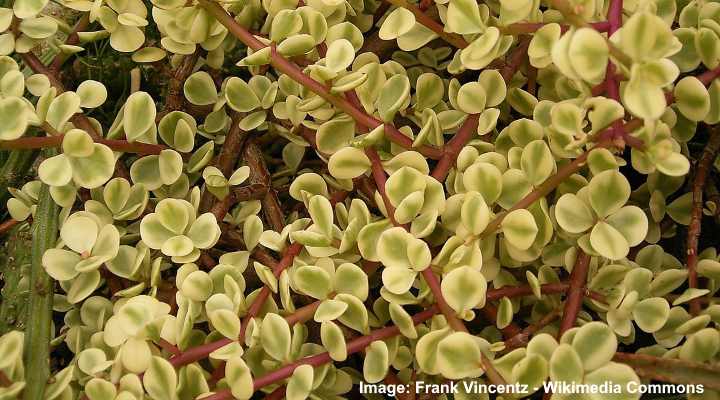
An important care factor of elephant bush succulents is to grow them in well-draining soil
Elephant bush succulents must grow in porous sandy soil that has fast drainage. An ideal succulent soil mix combines 2 parts regular all-purpose potting soil, 1 part horticultural sand and 1 part perlite or pea gravel. Or you could buy a commercial succulent soil that is suitable for cactus plants or bonsai trees.
Growing elephant bush plants in fast-draining soil is one of the most critical care factors. You can amend the soil with poultry grit, pumice, or small pea gravel to improve drainage. But the most popular soil amendment for drainage is perlite. Although elephant plant succulents prefer “sandy” soil, too much sand in containers isn’t ideal. Sand tends to be too fine and can make the succulent soil too dense.
Elephant bush plants don’t like to sit in soggy soil with their roots always wet. The damp conditions cause root rot and can quickly cause plant death. So, soil consistency, the right pot, and proper watering techniques are vital for keeping Portulacaria succulents thriving.
Here are some handy tips for getting soil moisture right for elephant bush plants:
- Grow elephant bush in a porous unglazed clay pot to allow moisture to evaporate faster.
- Always use terracotta pots with large drainage holes in the bottom so that excess water drains fast.
- Don’t use a pot that is too big for the size of your plant.
- Hold off watering during winter when temperatures are generally cooler, there is less sunshine, and plant growth is dormant.
- Always check that the loose soil mix is completely dry before watering.
How to Water Elephant Bush Succulents
Portulacaria afra “Elephant Bush” needs watering only when the potting mix is dry. Overwatering is the most common way of killing succulents, and elephant bush is no exception. Water this succulent by pouring lukewarm water evenly in the pot until it drains out the bottom. Wait until the soil dries before watering again.
In warm, sunny summer weather, you may need to water elephant bush plants every week. However, you should let soil dryness be your watering guide. If you water the plant too often and the soil is overly moist, you risk causing root rot in your jade-like succulent.
The best watering technique for elephant bush succulents is the drench and dry method. Pour plenty of water through the soil to thoroughly soak it. Allow all the excess water to drip out. Then place the elephant bush pot in its preferred location. After five or so days, check the soil for dryness to see if it’s time to water the plant.
Related reading: How to water cactus plants and other desert plants.
The Best Temperature For Growing Elephant Bush (Portulacaria Afra)
Elephant bush plants thrive in average room temperatures. An ideal temperature range to grow Portulacaria afra plants is 65°F to 80°F (18°C – 27°C). Regarding nighttime temperatures, a range between 50°F and 55°F (10°C to 13°C) is perfect.
Remember that elephant bush tends to be sensitive to temperature fluctuations. So, it would be best if you protected the heat-loving succulent from cold drafts or warm air vents.
It’s also good to remember that direct midday sunlight through a window can overheat the plant. The intense sun and hot temperatures can result in scorched foliage and leaf drop.
Elephant bush succulents grow outdoors in USDA zones 10 and 11. If you plant these succulents in your garden, choose the sunniest spot, and ensure the ground has fast-draining soil. Elephant bush plants are not fast growers in the ground or pots.
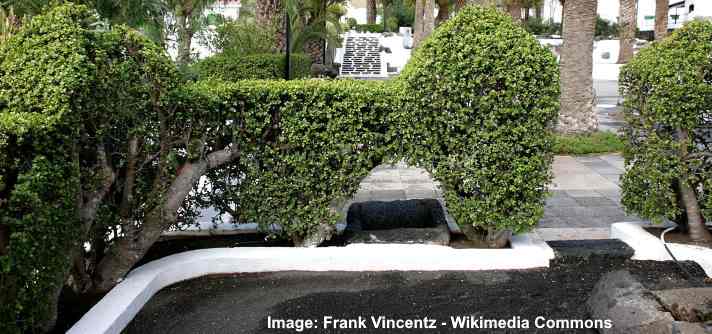
Elephant bushes can be grown outdoors in warmer temperatures such as these Portulacaria afra hedges in the Canary Islands
You can also grow elephant bush plants in containers and take them outside in summer in temperate climates. The jade-colored succulent trailing foliage can add natural accents to your patio, deck, or balcony. You should take the elephant bush pots back indoors when temperatures fall below 50°F (10 °C).
Moving elephant bush plants indoors in the fall sometimes results in leaf drop. To help avoid this, place the plant in the brightest, warmest room to reduce stress.
Portulacaria Afra “Elephant Bush” Humidity Needs
Elephant bush succulents don’t need high humidity to grow well. Usually, the dry air of homes is ideal for growing most kinds of succulents. As long as you are not overwatering the elephant bush, you shouldn’t have to worry about humidity.
Portulacaria afra can be susceptible to sudden changes in humidity. These issues are usually related to cooling or heating homes. Elephant bush plants don’t like being in drafts. So, protect them from the air conditioning airflow in summer or warm heating vents in winter. The overly-dry air can cause the plant to lose leaves.
Repotting an Elephant Bush (Portulacaria Afra) Plant
Elephant bush is a slow-growing variety of succulent and doesn’t require frequent repotting. It’s time to repot a Portulacaria afra plant when you notice roots poking out the drainage hole. To repot the trailing succulent, choose a container one or two sizes larger than its current one.
When repotting the plant, choose an appropriate fast-draining succulent soil mix.
Repotting Rainbow Elephant Bush (Portulacaria Afra ‘Variegata’)
Variegated elephant bush plants grow somewhat slower than the “jade” variety. Also, rainbow elephant bush plants are smaller than the non-variegated sort. So, the Portulacaria afra ‘Variegata’ needs repotting less often than other types of Portulacaria.
Pruning Elephant Bush Succulents
Portulacaria species tolerate heavy pruning to shape the plant and remove leggy, trailing stems. This woody succulent produces buds wherever branches are removed. This growth habit makes it easy to prune elephant bush succulents into the desired shape. To prune Portulacaria foliage, snip off the unwanted leaf clusters at the ends of branches.
How to Propagate Portulacaria Afra “Elephant Bush” Plants
Elephant bush is an easy succulent to propagate. The easiest and fastest elephant bush propagation method is by stem cuttings. Cut off a healthy section of stem that has lush foliage. Allow the stem to dry for a few days so that the “wound” can heal. Then plant the stem in an appropriate potting mix and keep the cutting warm and moist to encourage rooting.
You can also propagate elephant bush succulents when repotting the plant. You can divide parts of the root that have thick, healthy-looking stems.
As with many types of succulents, healthy elephant bush leaves also grow roots when placed in soil. However, propagating Portulacaria afra this way takes longer and is less successful.
Top tip for elephant bush propagation: Don’t remove healthy leaves that have dropped onto the potting soil. They often take root and start growing new plants that you can transfer to a new pot.
Are Elephant Bush Plants Toxic?
Portulacaria afra is not toxic. In some countries, leaves from elephant bush plants are used to add a sour flavor and juicy crunch in tasty salads.
Before trying elephant bush leaves, make sure that you have a species of Portulacaria afra plant. Elephant bush looks similar to jade plants (Crassula), which are toxic and should never be eaten.
Pest and Diseases Affecting Portulacaria Afra “Elephant Bush” Succulents
Elephant bush is susceptible to mealybugs, spider mites, and whitefly. Use a neem oil solution to get rid of these houseplant bugs naturally. Combine 2 tsp. organic neem oil with 1 tsp. liquid Castile soap with a quart (1 l) of warm water. Fill a spray bottle with the solution and douse the succulent foliage to get rid of pests from your elephant bush.
Related reading: How to identify common houseplant pests.
The most common disease to affect elephant bush growth is root rot. This fungal disease is easy to avoid if you water your succulents properly. As a rule, only water elephant bush plants when the soil is dry.
Problems Growing Portulacaria Afra (Elephant Bush Succulents)
Elephant bush succulents are easy to grow at home if you give them enough light and don’t overwater them. However, there are a few issues that can affect Portulacaria afra plants.
Why do elephant bush plants drop leaves?
Portulacaria afra succulents can start dropping leaves due to fluctuations in temperature, light, or humidity. Usually, bringing an elephant bush indoors where there is less sunlight causes leaves to fall. Also, leaves can start dropping from these succulents if placed in drafts or near warm air vents.
Portulacaria afra leaves are turning yellow, what should I do?
Yellow leaves on elephant bush succulents are usually due to overwatering. Roots that sit in soggy soil can’t absorb nutrients to “feed” the plant. The result is yellowing leaves that eventually die. To help revive the Portulacaria afra plant, you can move it to a brighter location so that moisture evaporates faster.
You may need to refresh the potting soil if it’s not draining fast enough. Generally, the ideal potting soil for elephant bush plants should dry out in a few days. If the soil is damp for longer, you will need to amend it with perlite, pea gravel, or pumice. Also, check that the plant isn’t rootbound. A dense root system can mean that water takes longer to drain and become waterlogged.
Related articles:
